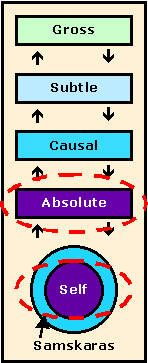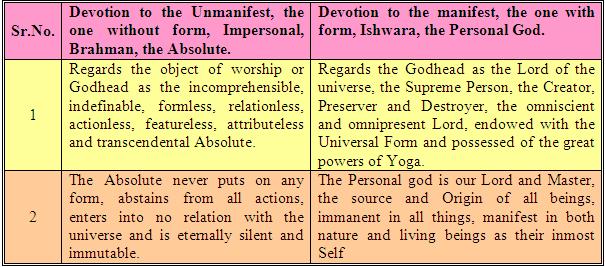Patanjali’s Yoga Sutras – Chapter 1: (Types of Engrossments, cont.; Sutras 1.44-1.46)
 Yoga Sutra (1.44) – etaya eva savichara nirvichara cha sukshma-vishaya vyakhyata. Etaya means by this or by these; Eva is also; savichara means investigation accompanied by subtle thoughts (sa = with, vichara = subtle thoughts); Nirvichara is investigation devoid of subtle thoughts (nir = without, vichara = subtle thoughts); Chais and; Sukshma means subtle; Vishaya is objects; Vyakhyata means explained, described or defined.
Yoga Sutra (1.44) – etaya eva savichara nirvichara cha sukshma-vishaya vyakhyata. Etaya means by this or by these; Eva is also; savichara means investigation accompanied by subtle thoughts (sa = with, vichara = subtle thoughts); Nirvichara is investigation devoid of subtle thoughts (nir = without, vichara = subtle thoughts); Chais and; Sukshma means subtle; Vishaya is objects; Vyakhyata means explained, described or defined.
Translated this means… In the same way that these adsorptions (engrossments) characterized by gross objects (savitarka samapattih), and by subtle objects (nirvichara samapattih), and is known as savichara and nirvichara samapattih (Samadhi).
In this sutra, Patanjali refers back to his discussion of savitarka and nirvitarka samadhi described in the two previous sutras (1.42 – 1.43) as he distinguishes the deeper types of concentration (savichara and nirvichara samadhi). To understand the distinction between these, we must think about the differences between “gross objects” and “subtle objects” of concentration as defined through traditional yoga philosophy.
When practicing this sutra, each of the subtle objects is to be encountered, examined, understood, with an attitude of non-attachment; they are to be seen as “not-self.” As these obstacles are removed, the student moves closer to the goal, the realization of the true Self.
Yoga Sutra (1.45) – sukshma vishayatvam cha alinga paryavasanam. Sukshma is subtle; Vishayatvam means object or having as objects; Cha is and; Alinga means without characteristics, undefined or unmanifest; Paryavasanam is extending up to or ending at.
Translated this becomes… Having such subtle objects extends all the way up to un-manifest prakriti.
Swami Satchidananda says of this sutra “the mind has the power to go to the very root of the un-manifested nature.” Which begs the question – what is this “un-manifested nature?” Christopher Isherwood describes it as “Prakriti…the elemental, undifferentiated stuff of matter; the energy by which all phenomena are projected,” and he says that “as the meditative mind turns inward, it probes through the gross outer coverings of things to their subtle essences…”
Yoga Sutra (1.46) – tah eva sabijah samadhih. Tah is these, those or they; Eva means only; Sabijah means with seed, seeded; Samadhih (from Samadhi) deep absorption in meditation, ecstasy.
This sutra is translated to mean… These four previously mentioned varieties of absorption (engrossment) are the only types of concentrations (samadhi) which are objective, and have a seed for an object.
These represent the only four types of meditation on a gross object regardless of the school/system of meditation that is practiced. This sutra summarizes the previous four:
- 1. Savitarka samapattih with gross thoughts (sutra 1.42)
- 2. Nirvitarka samapattih without gross thoughts (sutra 1.43)
- 3. Savitarka samapattih with subtle thoughts (sutra 1.44)
- 4. Nirvitarka samapattih without subtle thoughts (sutra 1.45)
Patanjali insists that most people are unaware of things such as desire and aversion and how they constantly shape their subconscious minds, affecting every thought and action. Those who are dedicated and have seriously committed to yoga practice may become aware of their inner stumbling blocks, thereby gaining an opportunity to check these forces before they arise into action, sustaining belief in them. With meditation, these underlying “seeds” may be constantly pulling us back from both the process and object of our focus and this may continue until we reach a level of contemplation that allows our most basic inner nature (the “Self”) to become fully realized. Until we reach that level, Patanjali says that we will only reach a temporary union with anything nearing truth. Our ego-based self-identity will constantly draw us back into the whirlwind thoughts springing up from our subconscious conditioning. To overcome this “sliding back,” persistence, practice and patience are necessary.
Part 15 may be viewed by clicking on: The Teachings of Yoga (Part 15: Types of Engrossments)
*For part 14, click on: The Teachings of Yoga (Part 14: After the Mind is Stable)
*For part 13, click on: The Teachings of Yoga (Part 13: Stabilizing/Clearing the Mind, cont.) Links to parts 7 through 12 may be found at the bottom of part 13. Links to parts 1 through 6 may be found at the bottom of Page 7
*Rae Indigo is ERYT500.



